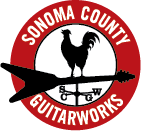Sometimes we get some pretty wild requests for guitar wiring. Phase switches, coil taps, treble bleed circuits, kill switches, talent knobs: none of it scares us.
Yesterday we rewired a PRS with just about every conceivable option: two Seymour Duncan P-Rails (installed backwards, by request) wired to Seymour Duncan Triple Shot rings (which allows the pickup to be switched to parallel or series wiring, and to activate either coil), a 5-way super switch (wired bridge, bridge/middle, bridge/neck, neck/middle, neck), a mini-phase switch and mini-series/parallel switch for the neck/bridge combo, a concentric stacked pot (top knob for volume, bottom knob for bass cut), and a treble bleed circuit. Check it out:
Laying out the control positioning:
Pickups loaded into the pickguard:
The Triple Shot circuit board:
We cleaned the back of the pickups with naptha, and attached the Triple Shot boards to the base plate:
Close up shots of the super switch and mini-switches. Note the heat shrink tubing added to the ends of all the tiny leads:
All wired up and ready to rock!
What did this accomplish? Well, Michael will get some typical sounds – double humbucker parallel, like a Les Paul – double single coil out of phase, like a strat – double P-90’s like a JR. He will also get many atypical sounds that are really cool: both rails out of phase in series, both p-90’s in series with the bass cut – more things are possible than we can write here, but the thing is, he had the vision and we made it happen. Thanks Michael!










IMO reverse mounting the bridge is essential to get a good humbucking sound, which is top priority for me (I also don’tuse P-rails neck). It cannot have the same “blurring” effect, due to similarity of signals from the 2 pickup points on the string, as a regular humbucker. Standard is more blurred and reversed is less blurred.
Also disagree with the .047 uF tone cap in SD’s diagrams, the standard .02 is better and I’m using .01 which is still quite strong on series humbucking, and gets interesting when 2-4 coils of the guitar are in parallel.
Bob: After acquiring another PRS with P-Rails mounted the “correct” way, I’m thinking of having Geoff flip this guitar’s P-Rails around to what Dr. Duncan recommends.
The real problem with my reverse mounting is the bridge rail coil by itself. The rails are very low-output, so when mounted right against the bridge, this one sounds strangled. So I rarely split to it alone — I usually select both bridge coils in parallel (using the Triple Shot).
My tentative conclusion: The better way to get classic single-coil tones out of P-Rails is to mount the P-90 coils on the outside, then use a bass roll-off pot (which Geoff installed for me) when you want to EQ from a P-90 tone to a sharper, Stratlike tone.
Those rail coils are low-output by design: To provide some quack when mounted as *inside* coils with standard 2 x humbucker spacing, and selected *together* in parallel. This trick actually works. But the flip side is, it’s tricky to split to either rail alone without adding quite a bit of gain.
Very interesting indeed. I asked about spinning the P-Rails around over at the Duncan forums several months ago myself and still have had no reply. I was curious to know if anyone had tried it and what they’d learned. THANK YOU for being adventurous and so like minded. I have P-Rails in 2 guitars – both installed as per the SD recommendations. I’ll have to try spinning then both around on one of them just to hear it.
Yes, we just flipped each pup 180 degrees around — in its own position on the guitar. This automatically “reverse”-wired each Triple Shot ring, which makes its operation more intuitive: You slide both mini-switches toward a coil you want to *activate*, not the one you want to turn off.
So this guitar now offers something like 26 coil combinations. That’s without even throwing the new bass roll-off knob into the mix.
I like everything except the neck rail coil alone — which sounds a bit anemic compared to everything else. I’m still experimenting with pickup heights and tilts. Might consult with Duncan about ultimately having Geoff replace the neck pup (only) with a pup that splits to more balanced coils, like maybe their Jazz model. Geoff also just pointed me to the Lindy Fralin “Unbucker.”
The P-Rails were just installed backwards physically, but were wired up normally.
ps – pardon my grammar, too much coffee o_O
SoHWheeat! Forget Nasa, hello Skunkworks!
Hey, I’m curious of the P-Rails were reversed Neck to Bridge, or Rail to P? (that is, the ‘neck’ pup is still a neck pup, just reversed the orientation)?
rock on doods
cheers
-Rob
There’s exactly one guitar-repair shop I would have trusted to do this complex mod. And there’s exactly one repair shop I would have expected to agree to the job.
I’m delighted with the results. Thank YOU guys for bringing the Lestercaster to life!